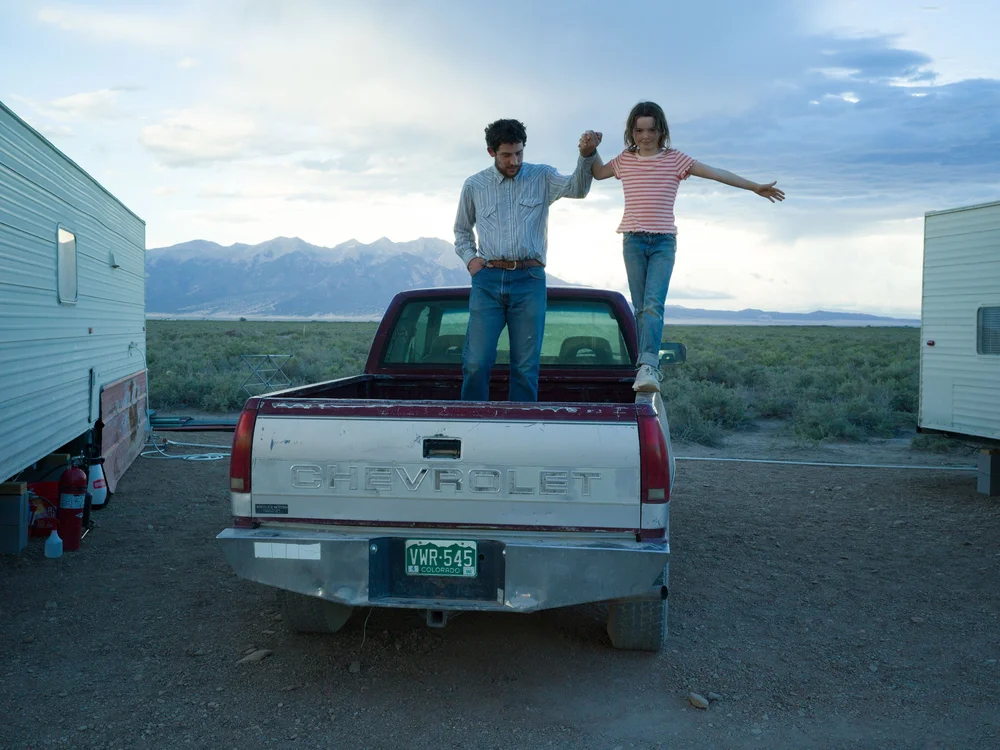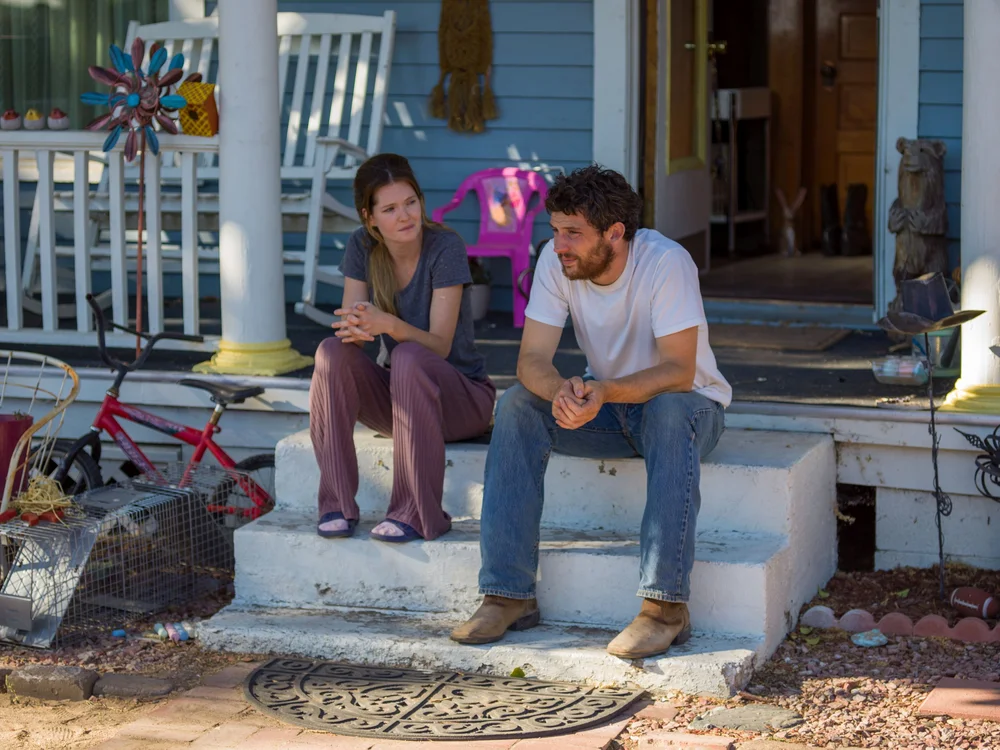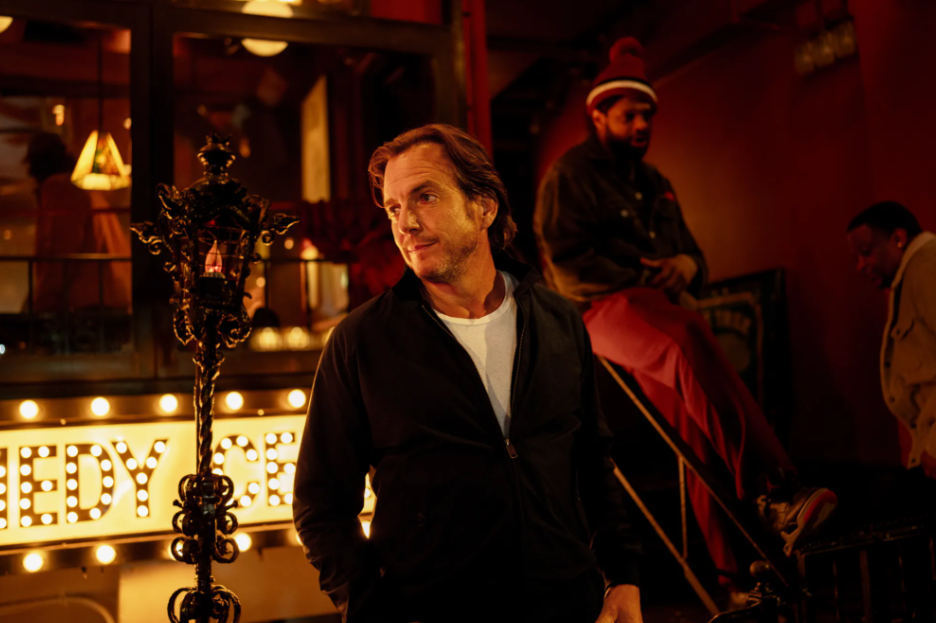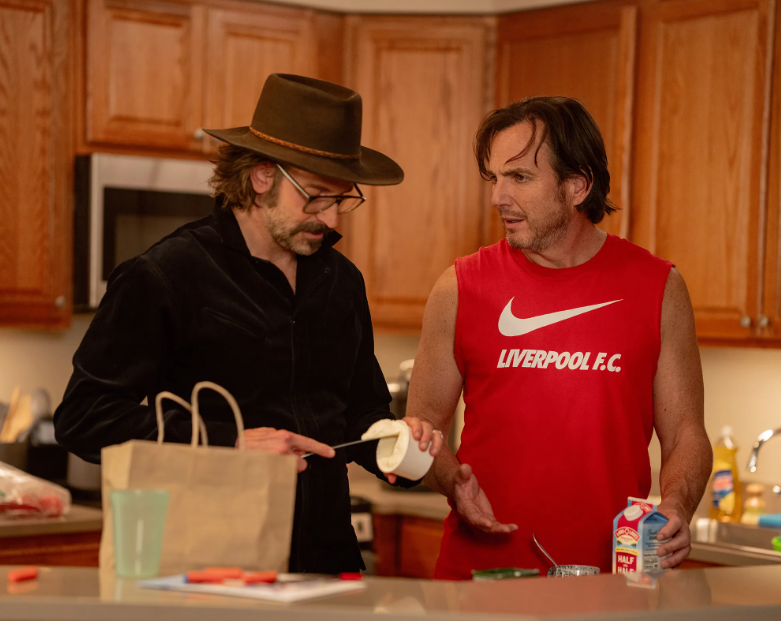
Images courtesy of Bleecker Street
REBUILDING— 4 STARS
There’s a striking montage that seals the rustic simplicity of Max Walker-Silverman’s sophomore directorial effort, Rebuilding. A major supporting character has died, and a funeral must be scraped together. The procession is a pine box casket ratchet-strapped to the bed of a pickup truck, followed by a single additional car of family members. On the way to where they are going, those two vehicles—coffin and all—stop on the side of the road to pick impromptu wildflowers for the service. They arrive at a fenced family plot of tombstones marred by recent wildfires. Tears are shed, a single acoustic guitar song is played, and no one is in a suit or black dress.
When you’re watching these stitched-together scenes in the final third of Rebuilding, never once are you questioning its crudeness. Knowing what you know at this point in the film, the commonly used words of grief consolation of “It’s what they would have wanted” come to mind, and there’s immediate peace in that. You are not looking down on any perceived lack of ceremony or decorum, because what’s there and the people putting together this personal tribute are beautiful and caring in their own right. Rebuilding crafts this level of care into its entire narrative.
LESSON #1: NOT EVERYONE WANTS TO “BUST OUT OF THIS COW TOWN”— So often in movies that depict rural American life, there are major or minor characters who, through their actions and words, are always looking to “bust out of this cow town.” The time period could be 150 years ago or the current 21st century, and the trend of dreaming about perceived more exciting places is the same. Screenplays frequently written by urban outsiders cannot fathom that plenty of people actually prefer the bucolic lifestyle. Rebuilding, a darling of the 2025 festival circuit going back all the way to the Sundance Film Festival, defies that trope with tremendous conviction.
Rebuilding opens on the cinders of Colorado wildfires, and shows a sullen man in a Bangora cowboy hat who has lost his home, burnt right down to the concrete foundation base positioned near a grove of blackened trees. Even in this dire condition, exceptionally shot by cinematographer Alfonso Herrera Salcedo (Ex-Husbands), absorbing the rich topography of Conejos County shooting locations, you can picture the previous forested beauty that would have been there. Nearby, there’s that aforementioned family cemetery, showing that generations have lived here, and your heart aches more. Thomas “Dusty” Fraser, Jr. (The Crown Emmy winner and busy 2025 movie star Josh O’Connor) has to circle the wagons and figure out what to do to make ends meet.
Dusty’s first step is selling the cattle that used to roam his 200 acres at auction, netting pennies on the dollar of their true value. He has supportive help nearby, in the form of other ranchers. Where there is infinite work to do, few have the money to pay to get it done. Dusty learns that a cousin in Montana could use some help through calving season and hopefully after, creating Rebuilding’s only glimpse of the “bust out of this cow town” trope.
Making that move would require Dusty to leave home, and he won’t do it. Even though they are divorced, his cooperative and understanding ex-wife Ruby (multiple Emmy Award nominee The White Lotus and Sirens Emmy nominee Meghann Fahy) and former mother-in-law Bess Hadley (2025’s comeback dame Amy Madigan of Weapons) live locally. Ruby and Dusty share a precocious elementary-aged daughter, Callie-Rose (excellent newcomer Lily LaTorre).
She adores her cowboy father and looks up to him with “I can do it” gumption. As soon as you see Callie-Rose and her father together—learning to ride horses and pulling WiFi from the library parking lot to do school homework—you know straightaway the reason Dusty is not high-tailing it to Montana to chase money. Next to Lily LaTorre putting forth one of the best child performances of the year, Josh O’Connor delivers a wonderfully tender performance that brightens this relationship and flickers the hope inside a defeated man. Madigan and Fahy add two more amicable characters who do right by Dusty and want the best for him, knowing a positive Dusty makes for a better Callie-Rose.
LESSON #2: MAKING THE BEST OF A TEMPORARY LIVING SITUATION— In a small inclusion of outside influence shown in Rebuilding, FEMA has put those displaced by the recent wildfires up in a lot of temporary mobile homes. There, Dusty befriends Mila (True Detective ensemble member and former champion boxer Kali Reis) and other families who are doing their level best to make “home where the heart is.” Thanks to Callie-Rose’s pluck and optimism, Dusty joins this makeshift community and finds his downtrodden heart lifted. They become his new people, and it’s a pleasant blend of spirit and diversity of people, all fearing they are being forgotten or that “temporary” is truly their unfortunate fate.
LESSON #3: “YOU GOT WHAT YOU GOT”— Amy Madigan’s Bess gets the line of the movie with this lesson title. In a film with plainspoken folks, very few people are going to peel off any type of lengthy monologue in Rebuilding. In a way, less is more, making small conversations reverberate with bonded importance. Yet, within this hardscrabble mantra of “you got what you got,” half of it is the resilience to make due with what you have through community resourcefulness and a softening of big dreams without regret. At the same time, that axiom is a past-tense reminder of how you likely have all the right things for your destiny around you, like loved ones, good friends, and a roof—no matter its type of construction—over your head.
Once again, a different movie than Rebuilding would be populated with social climbers or stiffer political messages, especially with the plot of citizens losing livelihoods and entire homes to natural disasters. That type of movie’s “what do we do about it” attitude would be in high gear. Yet, here’s Max Walker-Silverman, following up the well-received A Love Song, with a drama that emphasizes true familial roots before anything else. When done right, those basics are bigger than any flashy extras. Instead of only “home is where your heart is,” Rebuilding asserts that home is where you are welcome, and, even after everything, Dusty says it like it is: “I don’t like anywhere better.”









LOGO DESIGNED BY MEENTS ILLUSTRATED (#1357)
from Review Blog https://everymoviehasalesson.com/blog/2025/11/movie-review-rebuilding





























